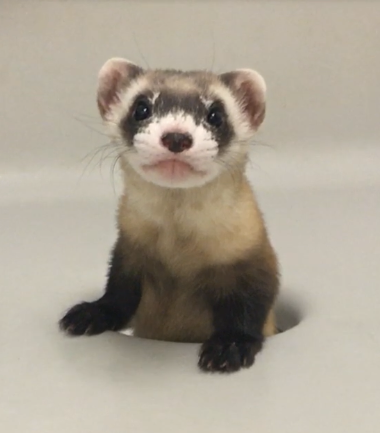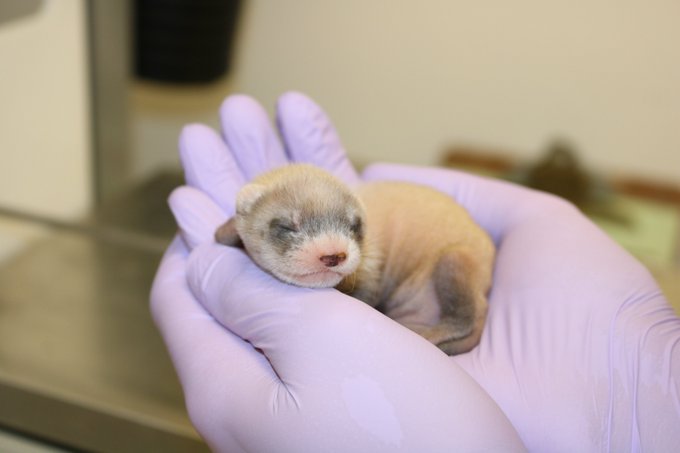






- Total
- General
- Arts
- Book
- Culture
- Economy
- Essay
- Fun/Joke
- History
- Hobbies
- Info
- Life
- Medical
- Movie
- Music
- Nature
- News
- Notice
- Opinion
- Philosophy
- Photo
- Poem
- Politics
- Science
- Sports
- Travel
Nature Amazing story - Resurrection of a lost species
2021.02.19 09:49
|
A black-footed ferret has been cloned, a first for a U.S. endangered species
Posted:
 .......... ..........
.............
Elizabeth Ann, the first cloned black-footed ferret and first-ever cloned U.S. endangered species, at 68-days old. (Credit: USFWS National Black-footed Ferret Conservation Center.)
CHEYENNE, Wyo. (NEXSTAR) — The first U.S. endangered species has been cloned — a black-footed ferret duplicated from the genes of an animal that died more than 30 years ago. Elizabeth Ann was born in a Colorado facility on Dec. 10, the U.S. Fish and Wildlife Service announced Thursday. The slinky predator is a genetic copy of a ferret named Willa, who died in 1988 and whose remains were frozen in the early days of DNA technology. “Although this research is preliminary, it is the first cloning of a native endangered species in North America, and it provides a promising tool for continued efforts to conserve the black-footed ferret,” Noreen Walsh, director of the Service’s Mountain-Prairie Region, said in a statement. Viagen, a company that clones horses and pet dogs and cats, cloned both animals. Once thought to be extinct, black-footed ferrets, also known as American polecats or prairie dog hunters, were brought back from the brink of vanishing after a Wyoming rancher discovered a small population on his land in 1981. All black-footed ferrets are descended from seven individuals, causing unique genetic challenges to recovery efforts, and scientists hope cloning can increase genetic diversity and disease resistance. “Maintaining and increasing wild populations and suitable habitat continues to be essential for black-footed ferret recovery and will remain a priority for the Service,” Walsh said. “Successful genetic cloning does not diminish the importance of addressing habitat-based threats to the species or the Service’s focus on addressing habitat conservation and management to recover black-footed ferrets.” The black-footed ferret recovery effort is the result of a partnership among the U.S. Fish and Wildlife Service and species recovery partners and scientists at Revive & Restore, ViaGen Pets & Equine, San Diego Zoo Global, and the Association of Zoos and Aquariums. The Associated Press contributed to this report. |
Comment 2
-
From another article:
The advance is a milestone for the conservation of black-footed ferrets, North America’s only native ferret. This species was once found over vast swathes of the American West, but they dwindled as farmers and ranchers eliminated their primary prey, prairie dogs. By the 1970s they were thought to be extinct. Then, in 1981, a ranch dog led scientists to a colony of 18 on a property in Wyoming.
Those survivors became the basis of a captive-breeding program managed in part by the U.S. Fish and Wildlife Service in Colorado, and the animals have since been reintroduced to eight states in the Great Plains. But only seven of the original wild animals bred, and all living ferrets are closely related. Their wild population today is roughly 400 to 500, says Pete Gober, black-footed ferret recovery coordinator for the service.
This new clone is a genetic copy of a wild female named Willa, who died in the mid-1980s in Wyoming and has no living descendants. Her cells have been cryopreserved at the Frozen Zoo, a program of San Diego Zoo Global that has collected samples from some 1,100 rare and endangered species worldwide. Researchers hope to breed Elizabeth Ann and introduce her offspring into the wild to inject much-needed genetic diversity into the population.


Amazing science !! A member of an extinct species has been brought back to life !!
Are we getting to be near the capacity of God ?? How far are we going to go?
This news is all over the Internet already.
"I, we, or our website" do not profit even a penny by copying this article into our website.
So, here it is, despite the copy-right warning.